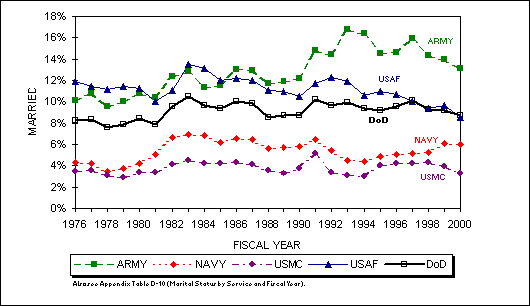
| |
|
|
|
|
|
|
|
|
|
|
|
|
|
|
|
|
|
|
|
|
|
|
|
|
|
|
|
|
|
 |
|
|
|
|
|
|
|
|
|
|
|
||||||||||||||||||
| |
|
|
|
|
|
|
|
||||||||||||||||||||||
| |
|
||||||||||||||||||||||||||||
| |
|
|
|
|
|
|
|
|
|
|
|
|
|
|
|
||||||||||||||
|
Marital Status The majority of accessions are young high school graduates and the military is often their first full-time job. Thus, very few are married. In FY 2000, 8 percent of male and 11 percent of female recruits were married, compared to 51 and 41 percent of male and female enlisted members, respectively. Table 2.6 compares marriage rates of accessions in the Services with 18- to 24-year-old civilians in the labor force. Civilians are more likely to be married than accessions (15 versus 9 percent). Within the Services, Army recruits are most likely to be married (13 percent) and Marine Corps recruits are least likely (3 percent). Figure 2.4 shows marital status trends for FYs 19762000 by Service.
Research shows that marriage is important to a members long-term career and can enhance individual readiness. [footnote 27] This is true if the member is in a strong marriage to a supportive but independent spouse. However, combining marriage and a military career can create challenges for younger Servicemembers as well as for the Service. Entering into marriage just prior to or soon after enlisting can place extra burdens on the recruit, the family, and the military, particularly when frequent or unexpected deployments separate the "new" family. Thus, marital status trends of accessions (and members) are an important characteristic to monitor.

Figure 2.4. Marital status trends of Active Component NPS accessions, by Service, FYs 19762000. [footnote 27] Office of the Assistant Secretary of Defense (Personnel and Readiness), Family Status and Initial Term of Service, Volume I - Summary (Washington, DC: Author, December 1993). [back to paragraph] |
||||||||||||||||||||||||||||||||||||||||||
|
|
||||||||||||||||||||||||||||||||||||||||||